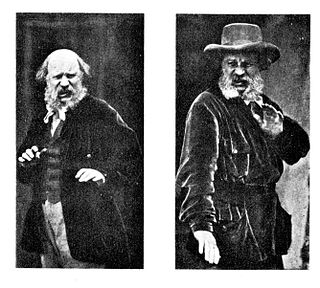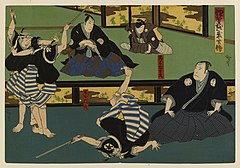
The chimpanzee, also simply known as the chimp, is a species of great ape native to the forests and savannahs of tropical Africa. It has four confirmed subspecies and a fifth proposed one. When its close relative the bonobo was more commonly known as the pygmy chimpanzee, this species was often called the common chimpanzee or the robust chimpanzee. The chimpanzee and the bonobo are the only species in the genus Pan. Evidence from fossils and DNA sequencing shows that Pan is a sister taxon to the human lineage and is thus humans' closest living relative. The chimpanzee is covered in coarse black hair, but has a bare face, fingers, toes, palms of the hands, and soles of the feet. It is larger and more robust than the bonobo, weighing 40–70 kg (88–154 lb) for males and 27–50 kg (60–110 lb) for females and standing 150 cm.

Ethology is a branch of zoology that studies the behaviour of non-human animals. It has its scientific roots in the work of Charles Darwin and of American and German ornithologists of the late 19th and early 20th century, including Charles O. Whitman, Oskar Heinroth, and Wallace Craig. The modern discipline of ethology is generally considered to have begun during the 1930s with the work of the Dutch biologist Nikolaas Tinbergen and the Austrian biologists Konrad Lorenz and Karl von Frisch, the three winners of the 1973 Nobel Prize in Physiology or Medicine. Ethology combines laboratory and field science, with a strong relation to neuroanatomy, ecology, and evolutionary biology.

Victimology is the study of victimization, including the psychological effects on victims, the relationship between victims and offenders, the interactions between victims and the criminal justice system—that is, the police and courts, and corrections officials—and the connections between victims and other social groups and institutions, such as the media, businesses, and social movements.

The bonobo, also historically called the pygmy chimpanzee, is an endangered great ape and one of the two species making up the genus Pan. While bonobos are, today, recognized as a distinct species in their own right, they were initially thought to be a subspecies of Pan troglodytes, due to the physical similarities between the two species. Taxonomically, members of the chimpanzee/bonobo subtribe Panina—composed entirely by the genus Pan—are collectively termed panins.
Violence is the use of physical force to cause harm to people, non-human animals, or property, such as pain, injury, death, damage, or destruction. Some definitions are somewhat broader, such as the World Health Organization's definition of violence as "the intentional use of physical force or power, threatened or actual, against oneself, another person, or against a group or community, which either results in or has a high likelihood of resulting in injury, death, psychological harm, maldevelopment, or deprivation."
Observational learning is learning that occurs through observing the behavior of others. It is a form of social learning which takes various forms, based on various processes. In humans, this form of learning seems to not need reinforcement to occur, but instead, requires a social model such as a parent, sibling, friend, or teacher with surroundings. Particularly in childhood, a model is someone of authority or higher status in an environment. In animals, observational learning is often based on classical conditioning, in which an instinctive behavior is elicited by observing the behavior of another, but other processes may be involved as well.
A crime of passion, in popular usage, refers to a violent crime, especially homicide, in which the perpetrator commits the act against someone because of sudden strong impulse such as anger or jealousy rather than as a premeditated crime. A high level of social and legal acceptance of crimes of passion has been historically associated with France from the 19th century to the 1970s, and until recently with Latin America.
A feud, also known in more extreme cases as a blood feud, vendetta, faida, clan war, gang war, private war, or mob war, is a long-running argument or fight, often between social groups of people, especially families or clans. Feuds begin because one party perceives itself to have been attacked, insulted, injured, or otherwise wronged by another. Intense feelings of resentment trigger an initial retribution, which causes the other party to feel greatly aggrieved and vengeful. The dispute is subsequently fuelled by a long-running cycle of retaliatory violence. This continual cycle of provocation and retaliation usually makes it extremely difficult to end the feud peacefully. Feuds can persist for generations and may result in extreme acts of violence. They can be interpreted as an extreme outgrowth of social relations based in family honor. A mob war is a time when two or more rival families begin open warfare with one another, destroying each other's businesses and assassinating family members. Mob wars are generally disastrous for all concerned, and can lead to the rise or fall of a family.

Sociobiological theories of rape explore how evolutionary adaptation influences the psychology of rapists. Such theories are highly controversial, as traditional theories typically do not consider rape a behavioral adaptation. Some object to such theories on ethical, religious, political, or scientific grounds. Others argue correct knowledge of rape causes is necessary for effective preventive measures.
The killer ape theory or killer ape hypothesis is the theory that war and interpersonal aggression was the driving force behind human evolution. It was originated by Raymond Dart in the 1950s; it was developed further in African Genesis by Robert Ardrey in 1961.

In traditional Albanian culture, Gjakmarrja or hakmarrja ("revenge") is the social obligation to kill an offender or a member of their family in order to salvage one's honor. This practice is generally seen as in line with the social code known as the Canon of Lekë Dukagjini or simply the Kanun. The code was originally a "a non-religious code that was used by Muslims and Christians alike."

Pornography has been defined as sexual subject material "such as a picture, video, or text" that is intended for sexual arousal. Made for the consumption by adults, pornography depictions have evolved from cave paintings, some forty millennia ago, to virtual reality presentations. A general distinction of adult content is made classifying it as pornography or erotica.
An honor killing, honour killing, or shame killing is a traditional form of murder in which a person is killed by or at the behest of members of their family, due to culturally sanctioned beliefs that such homicides are necessary as retribution for the perceived dishonoring of the family by the victim. Honor killings are often connected to religion, caste, other forms of hierarchical social stratification, or sexuality. Most often, it involves the murder of a woman or girl by male family members, due to the perpetrators' belief that the victim has brought dishonor or shame upon the family name, reputation or prestige. Honor killings are believed to have originated from tribal customs.

Pornography has been defined as any material in varying forms, including texts, video, photos or audio that is consumed for sexual satisfaction and arousal of an individual or partnership. The effects of pornography on individuals or their intimate relationships have been a subject of research.

Tool use by non-humans is a phenomenon in which a non-human animal uses any kind of tool in order to achieve a goal such as acquiring food and water, grooming, combat, defence, communication, recreation or construction. Originally thought to be a skill possessed only by humans, some tool use requires a sophisticated level of cognition. There is considerable discussion about the definition of what constitutes a tool and therefore which behaviours can be considered true examples of tool use. A wide range of animals, including mammals, birds, fish, cephalopods, and insects, are considered to use tools.

Envy is an emotion which occurs when a person lacks another's quality, skill, achievement, or possession and wishes that the other lacked it.

Disgust is an emotional response of rejection or revulsion to something potentially contagious or something considered offensive, distasteful or unpleasant. In The Expression of the Emotions in Man and Animals, Charles Darwin wrote that disgust is a sensation that refers to something revolting. Disgust is experienced primarily in relation to the sense of taste, and secondarily to anything which causes a similar feeling by sense of smell, touch, or vision. Musically sensitive people may even be disgusted by the cacophony of inharmonious sounds. Research has continually proven a relationship between disgust and anxiety disorders such as arachnophobia, blood-injection-injury type phobias, and contamination fear related obsessive–compulsive disorder.
Elevation is an emotion elicited by witnessing actual or imagined virtuous acts of remarkable moral goodness. It is experienced as a distinct feeling of warmth and expansion that is accompanied by appreciation and affection for the individual whose exceptional conduct is being observed. Elevation motivates those who experience it to open up to, affiliate with, and assist others. Elevation makes an individual feel lifted up and optimistic about humanity.
Christopher Boehm (1931–2021) was an American cultural anthropologist with a subspecialty in primatology, who researched conflict resolution, altruism, the evolution of morality, and feuding and warfare. He was also the Director of the Jane Goodall Research Center at University of Southern California, a multi-media interactive database focusing on the social and moral behavior of world hunter gatherers. Boehm died on November 23, 2021, at the age of 90.
Relational models theory (RMT) is a theory of interpersonal relationships, authored by anthropologist Alan Fiske and initially developed from his fieldwork in Burkina Faso. RMT proposes that all human interactions can be described in terms of just four "relational models", or elementary forms of human relations: communal sharing, authority ranking, equality matching and market pricing.
















